Silken
Threads
Of Deceit
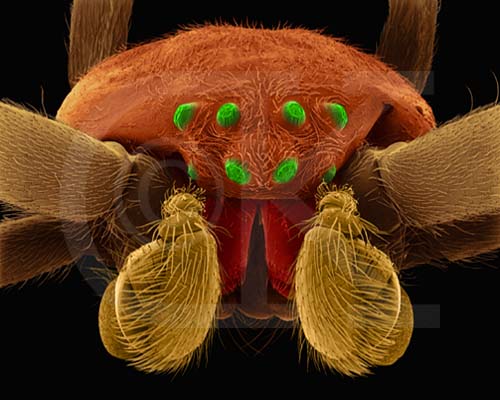
Garden
Spider
Viewed Using Scanning Electron Microscope
(Image
copyright- Dr. Dennis Kunkel)
3/7/2000
By Jay Reynolds
At the website
of Clifford Carnicom,
a display is made of material alleged to be "suspected chemtrail
ground samples" that he says were sent to him "in November
and December of 1999 " from undisclosed locations in "eastern
Oregon and Sacramento area CA." Carnicom further states that
"unusual aircraft activity was observed in conjunction with
the presence of the ground samples.
However, his report
begins with a contradiction in that he also says, "The first
sample was directly correlated with aerial activity; the second
sample was found by a motorist on an open and paved highway in
the Sacramento CA area (airbone [sic]fibers were observed prior
to photography). "
This article will
discuss Carnicom's claims, review what the material could
be , and discuss what needs to be done to properly identify the
material.
The Carnicom
Claims
Carnicom states:
"THE MOST OUTSTANDING
CHARACTERISTICS
OF THE SAMPLES RECEIVED ARE:
1. The size of the fibers; microscopic and not normally visible
to the human eye.
2. Extreme adhesiveness
3. Extreme elasticity
4. Wave nature of the fibers
The analysis on the sample
fibers now includes the following methods:
1. Visual Analysis
2. Metric (measurement)
3. Chemical
4. Infra-red Spectrometry
5. Environmental conditions of sampling
6. Health Considerations"
The above analysis in actuality
DOES NOT include items #4, #5, or #6 as claimed above, they are
each marked as "[Unfinished segment]". The item #3 above,
listed as "chemical", IS NOT a laboratory chemical analysis,
but is an unorthodox "chemical test" which includes
comparison of reactions between material alleged to be "spider
web" and the alleged "ground sample fibers"
.
This "chemical test" includes applications of the following
substances to both materials:
"Hair Perm Solution"
"Sulphuric Acid"
[a mixture of] "methyl ethyl ketone and acetone"
Carnicom does claim
to have viewed the material under 100X microscopy
and found the alleged ground sample to be "LESS than one
micron"
in diameter, and alleged "spider web" he measured to
be "7 microns" in diameter.
[For a review of metric measurement,
click
HERE
Point #1
Carnicom's
photographs may establish that the material he collected is of
a certain size, and he may have also compared the alleged "ground
sample" to a certain type of "spider web", but
size alone does not constitute definitive proof that they are
not actual spider silk.
Point #2
The application
of various chemicals to a material does not constitute a chemical
analysis. Only an actual, specific chemical analysis can determine
the exact chemical and elemental composition of a material.
WHAT IS NORMAL
SPIDER SILK?
Spider silk is familiar
to most people, but few actually understand the nature of how
it is formed, and the range of physical characteristics it can
exhibit. It is indeed a fascinating material which serves many
functions and has many possibilities. As Carnicom states, it is
an elastic and sometimes adhesive material, with unique properties
of strength relative to it's other properties.
As seen in the image
below under high magnification, spiders secrete their silk from
glands located on their lower side. The secretions are liquid,
but harden after they emerge from spigots located on organs known
as spinnerets. This quote sums up the specifics:
"There are
several glands located at the spider's abdomen,
which produce the silken thread. Every gland produces a
thread for a special purpose. There are seven different glands
known. But each spider possesses only some of these
glands and not all seven together.
The glands known
as Glandula Ampulleceae major
and minor is used for the silk of the walking
thread. Glandula Pyriformes is used for the production
of the attaching threads. Glandula Aciniformes produces
threads for the encapsulation of prey. Glandula
Tubiliformes produces thread for cocoons. Glandula
Coronatae is used for the production of the adhesive threads.
Normally a spider
has three pairs of spinners. But there
are spiders with just one pair or as many as with four
pairs of spinners. Every spinner has it own function.
There are small tubes in the spinners, which are connected
to the glands. The number of tubes varies between 2 and 50.000."
As you can see from
the photos below, the large number of spigots produce multiple
fibrils which then are combined by the spider into bundles similar
to cables. Some silks are used for trapping prey and are spread
with an adhesive, sticky substance for that purpose, while some
are not.
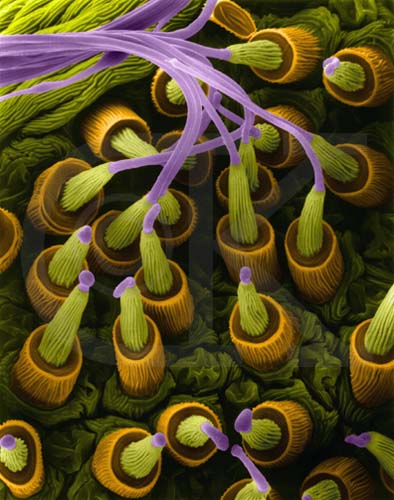
Spider Spinneret (silk being
secreted from piriform gland spigots, Spiny Back Spider, Gastercantha
sp.)
(SEM x3,740)
(Image
copyright- Dr. Dennis Kunkel)
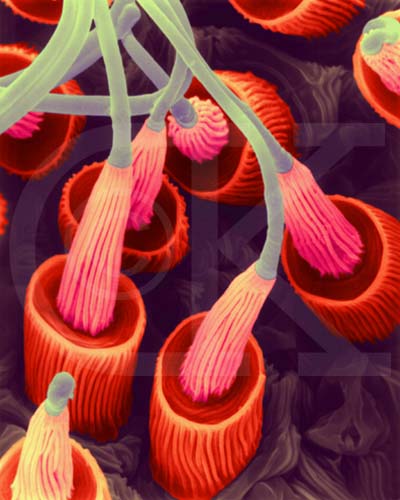
Spiny Back Spider
Piriform Silk Glands
Secreting Silk,
Castercantha sp.
(SEM x8,025)
(Image
copyright- Dr. Dennis Kunkel)
The spinnerets of a
typical spider viewed from the rear. Drawing by Ben Prins. Annotation
by Bill Amos.
1. Colulus, a vestigial spinneret, 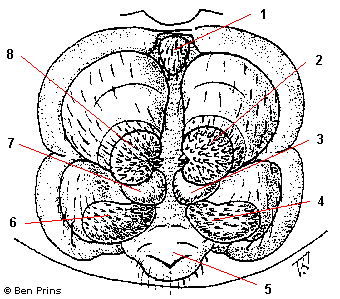
probably without function.
2. Anterior spinneret.
3. Median spinneret.
4. Posterior spinneret.
5. Anus.
6. Posterior spinneret.
7. Median spinneret.
8.Anterior Spinneret
What are the Physical
Characteristics of Spider Silk?
Carnicom alleges that,
"In addition to being substantially smaller in size than
the spider webs that were measured at 7 microns, the fibers of
the ground sample shown are uniformly adhesive, and show no such
separation of function or form."
The book "Biology
of Spiders"[1], states:
"page 112-
"In orb-web spiders, though, the amount of silk leaving the
gland can be controlled by valves situated just in front of the
spigots(Fig. 84). The diameter of the valves can be regulated
by muscular action, thereby varying the thickness of the thread
(R. S. Wilson, 1962a, b). Most silk threads have a diameter of
only a few microns(Fig 85), and many are even thinner than 1 micron.
A well-known example of extremely fine silk threads is found in
the catching silk ("hackle band") of cribellate spiders,
where the individual fibers measure only 0.01-0.02 microns(Fig.
92c)." [1]
While some spider
silk may be produced that matches the 7 micron silk displayed
by Carnicom, some spider silk can be up to 100 times smaller.
The above answers
my POINT# 1 above, and proves that the physical size of the alleged
"ground sample" material is not necessarily inconsistent
with the known size of spider silk.
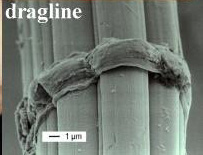
Scanning Electron Micrograph
of Nephila Clavipes Spider
Dragline Silk Shows Diameter
of 12 Microns Overall With
Threads up to 4 Microns
(courtesy
of Dr. K. Augsten IMB-Jena)
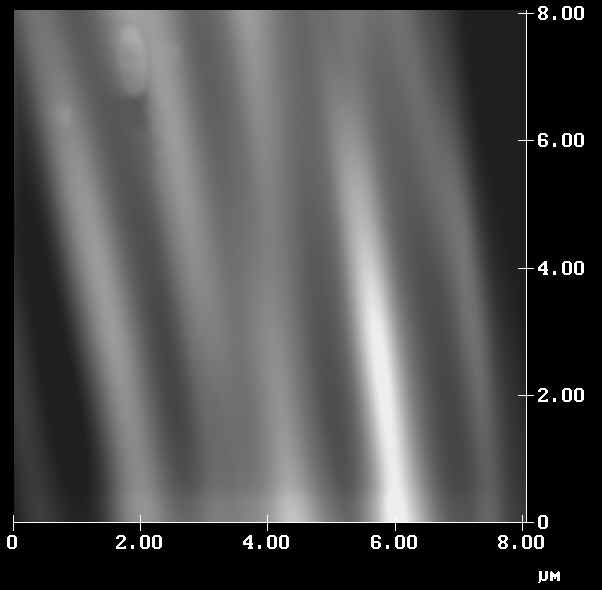
Atomic Force Microscope
Image of Spider Silk
Shows Diameter of
7-8 Microns Overall
and Thread Diameter 1
Micron or Less
(Image
from The Claremont Colleges)
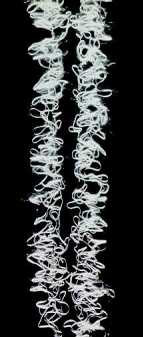
Carnicom states:
"Spider webs do not possess microscopic
wave forms, and are not formed at the sub-micron
level. Wave forms are fairly common in synthetic
fibers such as nylon and polyester. "
The image at left shows
cribellate spider silk,
which is known to have just such a wavy texture
which is "combed out" by strong bristles on the spider's
legs which are equipped with fine cuticular teeth.
Photo- Ed Nieuwenhuys
In an effort to
portray the alleged "ground sample"
as being other than spider silk, Carnicom states:
"No fluid substance is visible on the exterior of any
of the ground sample fibers."
However, the previously
referenced book states:
"The catching
threads of cribellate spiders are especially interesting because
they function without any gluey substance - unlike the sticky
threads of ecribellate spiders. Additionally, the cribellate silk
has some adhesive properties, although these properties are not
well understood."-page 121 [1]
Carnicom finds that one distinguishing characteristic of the alleged
"ground sample" is "Extreme elasticity". Normal spidersilk
has long been known to
be both extremely strong and elastic, and in fact, much progress
has been made towards producing it commercially for many uses.
 What are the Chemical
Characteristics of Spider Silk?
Spider silk is a
natural polypeptide polymeric protein, which is a long chain of amino
acids. Spider silk
is a scleroprotein, a member of the group of proteins
that provide structure to living things. Other scleroproteins
include collagen, which makes up ligaments, and keratin, which makes up fingernails, feathers,
horns and hoofs. The chemical difference between these proteins
is the mole percent and sequence of various amino acids present
in different proteins.
Specifically, the
protein that makes up spider silk is known as fibroin, and recent research has identified
two subsets of proteins within fibroin which make up spider silk,
spidroin 1 and spidroin 2. The following quote summarizes what is currently known
about the chemical composition of spider silk:
"The mole
percent and sequence of the amino acids differentiates
What are the Chemical
Characteristics of Spider Silk?
Spider silk is a
natural polypeptide polymeric protein, which is a long chain of amino
acids. Spider silk
is a scleroprotein, a member of the group of proteins
that provide structure to living things. Other scleroproteins
include collagen, which makes up ligaments, and keratin, which makes up fingernails, feathers,
horns and hoofs. The chemical difference between these proteins
is the mole percent and sequence of various amino acids present
in different proteins.
Specifically, the
protein that makes up spider silk is known as fibroin, and recent research has identified
two subsets of proteins within fibroin which make up spider silk,
spidroin 1 and spidroin 2. The following quote summarizes what is currently known
about the chemical composition of spider silk:
"The mole
percent and sequence of the amino acids differentiates
natural polypeptides such as silk, mohair, spider silk, and human
hair. The composition of spider dragline silk, which emanates
from
the major ampullate gland, is dependent on species, diet, weather,
and other factors [2]. Hence, the composition provided in Table
I
for Nephila clavipes [3], a large spider found in the southeastern
part of US and elsewhere and whose silk has been studied as much
as any spider silk, should be considered exemplary rather than
definitive [2]. Values given are mole percents [3].
Gly Ala Gly Leu
Tyr Ser Asp Pro Cys
Nephila clavipes 40.3 28.4 10.1 4.5 3.1 3.0 1.9 1.7 0
The number average
molecular weight is in the 500,000 -750,000
g/m range [4]. Solvation is difficult to achieve, requiring harsh
(chaotic) solvents, such as LiBr or LiClO4 [2]." [2]
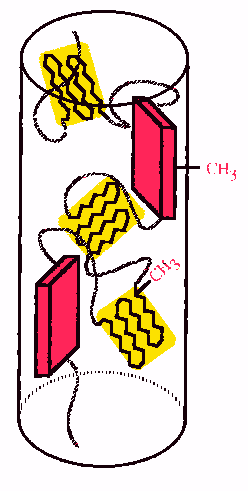
Model of spider dragline silk showing alanine crystals in both
well oriented sheets(rectangles) and unaggregated crystals
(waffled). The two differing crystal formations lie in a glycine
matrix(curved lines) and combined give spider silk it's unique
properties.
from Science
271:84­87 (1996)
In response to my
question about the typical amino acid composition of spider silk,
Dr.Merri
Lynn Casem wrote to
me:
"As you correctly state, alanine and glycine are the major
amino
acid components in spider silk making up 20 to 40% of the total
mole
percent. The ratios can vary depending on what type of silk it
is (spiders
can produce up to 8 different silks) My research and that of others
have
shown that the levels of serine become elevated (from 4% to 25%)
in the egg
casing silks of some spiders. I am not aware if the protein composition
is
known specifically for the ballooning silk, but I would guess
that it would
be the same as dragline or major ampullate silk. One characteristic
of most
known silks is the lack of the amino acids cysteine or methionine."
The standard chemical
analysis technique used to identify and quantify
amino acid composition is high performance liquid chromatography
(HPLC) . This type of analysis is widely available at commercial
and university laboratories.
Some spider silk
is known to have an adhesive substance which is described in "Biology
of Spiders" in this quote:
"A chemical
analysis of the sticky substance [of spidersilk-JR] revealed the
presence of nitrate, (KNNO3), phosphate(KH2PO4), and pyrrolidone
(C4H7NO) (Schildknecht et al., 1972)." -Page 116 [1]
 How Does This Material
get Airborne?
As mentioned in
my previous
article on contrails,
spider webs sometimes do fall from the sky, as a result of the
spider's technique of migration on air currents using their silk
to "balloon". The following quotes illustrate what is
known about this phenomenon:
"Such widespread
distribution leads to the question of how spiders manage to populate
very remote areas, such as islands, for instance. One explanation
is based on the ability of many young spiders to float through
the air on their own threads. This "ballooning", as
it is called, is actively undertaken by the spider. The spiderling
stands on "tiptoe", facing the wind, and inclines its
abdomen upward while exuding a silk thread. This strand is caught
by the slightest current, which can easily lift the spider. Usually
the voyage ends after a rather short distance. Under favorable
wind conditions, however, these aeronauts may attain quite remarkable
heights and distances. Spiders, as a kind of ‘aerial plankton,"
have ben caught from airplanes flying at altitudes of several
thousand meters(Gretsch, 1949;Glick, 1939). In 1832 Darwin noted
in his diary that innumerable small spiders had been blown into
the rigging of the Beagle 100km off the coast of South America."
"Formerly it was believed that only young spiders could fly
on their own threads, but recently it has been found that many
small spiders can do so as well (Richter, 1971; Blanke, 1973).
In the linyphiids, adult males and females can take to the air-
often thousands of them at a time(Bristowe, 1939; Van Wingerden
and Vugts, 1974; Vugts and Van Wingerden, 1976). Whereas the gossamer
threads of young spiderlings are seen in Indian summer, the mass
flights of linyphiids occurs during fall and winter. A prerequisite
for such aeronautical behavior is a sudden rise in temperature(Duffey,
1956)."-Page 233 [1]
Dr. Rod Crawford, curator of arachnids at the Burke Museum, Seattle
, Washington, conducted post-eruption
ecological recovery research
at the Mt. St. Helens blast site and discovered that large amounts
of ballooning spiders
How Does This Material
get Airborne?
As mentioned in
my previous
article on contrails,
spider webs sometimes do fall from the sky, as a result of the
spider's technique of migration on air currents using their silk
to "balloon". The following quotes illustrate what is
known about this phenomenon:
"Such widespread
distribution leads to the question of how spiders manage to populate
very remote areas, such as islands, for instance. One explanation
is based on the ability of many young spiders to float through
the air on their own threads. This "ballooning", as
it is called, is actively undertaken by the spider. The spiderling
stands on "tiptoe", facing the wind, and inclines its
abdomen upward while exuding a silk thread. This strand is caught
by the slightest current, which can easily lift the spider. Usually
the voyage ends after a rather short distance. Under favorable
wind conditions, however, these aeronauts may attain quite remarkable
heights and distances. Spiders, as a kind of ‘aerial plankton,"
have ben caught from airplanes flying at altitudes of several
thousand meters(Gretsch, 1949;Glick, 1939). In 1832 Darwin noted
in his diary that innumerable small spiders had been blown into
the rigging of the Beagle 100km off the coast of South America."
"Formerly it was believed that only young spiders could fly
on their own threads, but recently it has been found that many
small spiders can do so as well (Richter, 1971; Blanke, 1973).
In the linyphiids, adult males and females can take to the air-
often thousands of them at a time(Bristowe, 1939; Van Wingerden
and Vugts, 1974; Vugts and Van Wingerden, 1976). Whereas the gossamer
threads of young spiderlings are seen in Indian summer, the mass
flights of linyphiids occurs during fall and winter. A prerequisite
for such aeronautical behavior is a sudden rise in temperature(Duffey,
1956)."-Page 233 [1]
Dr. Rod Crawford, curator of arachnids at the Burke Museum, Seattle
, Washington, conducted post-eruption
ecological recovery research
at the Mt. St. Helens blast site and discovered that large amounts
of ballooning spiders
were the first colonizers to arrive. Responding to my query about
the phenomenon, he wrote:
"There is
no question that vast quantities of spider silk are in the air
at
almost any time (mainly daylight hours). For example, our studies
at Mt.
St. Helens in the early 80s, using "blasted" sites 7-30
km from likely
source areas, found an average of one ballooning spider landing
per square
meter per day! Multiply that by the number of square meters in
(for
example) your yard, which is closer to source areas and probably
has a
higher immigration rate... The mind boggles, doesn't it? Spiders
have
been known to "take off" en masse, possibly as many
as a million leaving
one acre field in a day under ideal conditions. That's a lotta
silk!
Large masses of airborne spider silk (as opposed to individual
threads) are from a different source -- they are believed to be
fragments
of the layer of "dragline" silk spiders leave over the
surface of a meadow
or a tree on days of high activity. When the light is right you
can see
this layer -- it's called "gossamer." There is no doubt
about its spider
origin. Updrafts can lift shreds of this material into the air
and that is
probably the main source of "masses" of spider silk
that go flying about.
I have no way of knowing if there is also artificial fiber
material flying about but there is so much spider silk out there
that no
other explanation is really needed."
Dr. Matt Greenstone, responding to my request for an evaluation of Carnicom's
presentation, said:
"Thank you
for this interesting story. The photos of material on the road
and
vehicle in Alaska certainly look a great deal like ballooning
silk. It is not
unusual to see ballooning lines more than thirty feet long, and
sometimes it
has a complex structure like that in the photos.
The structure
of any given silken strand, i.e. it's thickness, how many fibers
are involved, and whether it is wavy or has droplets, is very
varied. Some
silk IS wavy, and some adhesive silks do not have droplets."
Other articles discussing
ballooning spiders may be seen at:
"Thread For Heights"- New Scientist
"Pyroclastic Flows, Insects and Spiders"
Mt. St. Helens Recovery- Seattle Times
Dispersal of Spiderlings-ORNL
This Spider Silk Was Found
Near The
Same Area as the Carnicom "Ground Sample"
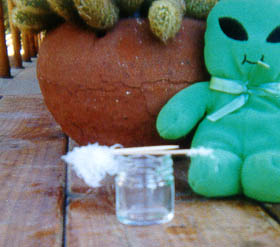 Spider Silk Sample
Found September 27, 1999
Spider Silk Sample
Found September 27, 1999
30 miles SE of Sacramento, CA, near Ione
Here is the eyewitness
report:
"I will try to
give you a review of why it is conclusable it
is spiderweb, beyond the fact I have seen this material along
with its passengers for a period of 23 years, on cars, roads,
trees, etc. on a seasonal basis.
On 9/27/99, while leaving the driveway, to go to the school, I
saw
clumps and strands of spider silk on the asphalt. While travelling,
I also saw strands descending from the air, up to 8 miles away.
So, upon returning, remembering the photo shown on
Carnicoms site, I then
handled and collected some strands on
a stick (also like his photo), and took some pics of some on the
ground and also on a stick.
While doing so,
the contractor I had called weeks before,
showed up to do a pest control job on an outbuilding. I asked
him to tell me what was the stuff on the ground and he
proceeded to tell me of the commoness and use of them
as a "predictor by farmers" of wet weather to come.
I did not wear protective gear. I did touch and stretch out
some of the webs. I did use a clean sterile jelly jar and
kept some of the webs on a granite counter at room temperature
for about a month. No change occurred over that period.
Offered some of my samples to anyone who wanted them,
but then became rather bored and decided to pitch them out.
The jar did remain sealed over the period I kept it. I collected
the webs from the ground using wooden skewers. The material
was very self adhesive and it was a bit difficult to place in
the
jar, without also including the stick itself. "
- By lila@goldrush.com
 Conclusions
Based on the factual
and documented information shown above, natural spider silk meets
all the "outstanding characteristics" of the material
presented by Carnicom which are: "size of the fibers",
"extreme adhesiveness", "extreme elasticity"
and "wave nature of the fibers".
Carnicom's work
shows an intentionally shallow presentation of what is known to
be normal, which should always be well understood before proceeding
to examine the unknown.
Carnicom has not
presented an actual chemical analysis of any sort, but claims
in a realaudio
file that a reporter
has not covered his story because:
“I then
informed the reporter that at this time certain lab
Conclusions
Based on the factual
and documented information shown above, natural spider silk meets
all the "outstanding characteristics" of the material
presented by Carnicom which are: "size of the fibers",
"extreme adhesiveness", "extreme elasticity"
and "wave nature of the fibers".
Carnicom's work
shows an intentionally shallow presentation of what is known to
be normal, which should always be well understood before proceeding
to examine the unknown.
Carnicom has not
presented an actual chemical analysis of any sort, but claims
in a realaudio
file that a reporter
has not covered his story because:
“I then
informed the reporter that at this time certain lab
results had come in, but that it could be easily proven that the
lab conclusions
were false, and that that portion of the story would not be discussed
unless the
paper indicated a willingness to investigate my claim to a sufficient
depth."
Thus, continuing
the pattern time
and time
again, promoters of
'chemtrails' claim to have found material, have information, photographs,
testimony or 'proof' but never actually show anything which can
be independently documented or verified.
It can be easily
seen at numerous websites discussing the issue of 'chemtrails'
that gullible people are quite willing to believe anything with
no sourcing, documentation, or verification at all. The result
of such action is to perpetuate misinformation, propagate rumor
and hoaxes, and promote an idea which has no substance.
I recommend that
Carnicom have proper analysis done of the material he claims to
have, document it in a verifiable form, and disclose all information
relative to it's original source . To do otherwise is to mislead
others with unsupported and uninformed speculation and heresay.
ADDENDUM
Clifford Carnicom
was given advance copy of this article,
and asked to commment. No response has been received as of 3/16/99.
References:
[1] Foelix, Ranier. Biology of Spiders, Harvard University
Press, 1982, ISBN 0-647-07431-9
[2] Simmons, A., Michal, C. A., & Jelinski, L. W. (1996).
Molecular orientation and two-component nature of the crystalline
fraction of spider dragline silk. Science, 271, 84-87.

 Back to Contrails, or 'Trails-Con?
Back to Jay Reynolds World
Back to Contrails, or 'Trails-Con?
Back to Jay Reynolds World













